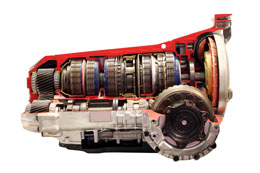
Automatic transmission is fairly commonplace now, as more and more drivers prefer having one less thing to worry about. However, there are certain problems, associated with it, which primarily include low efficiency and slipping.
A car’s transmission distributes the torque generated by the engine and makes maximum efficient use of the engine’s capacity. It is due to the car transmission that variable speeds of operation are made possible. It makes driving easier and lets the car itself handle the changing of gears, according to speed. There is no clutch pedal required and the driver has to only worry about steering, acceleration, and braking. However, it has its own set of problems.
Symptoms
Slipping is a serious problem. That is why, it helps if you know the symptoms of a transmission slipping out of gear, which are listed further.
Sudden High RPM Reading
Transmission slipping can cause an abnormal increase in engine RPM readings. If the reading increases beyond 3000 to 3500, then your engine may be going into overdrive, due to slipping.
Car Coasts For Longer Time
When driving, if you suddenly take your foot off the acceleration pedal, then it coasts for some distance before coming to a stop. When slipping occurs, you may notice that the car coasts for a longer time than normal, before it comes to a stop.
Gear Downshifting Has Slowed Down
Chances are that your car’s transmission might be slipping when gear downshifting is slower. Sometimes, downshifting is accompanied with an increase in RPM. Lagging of the car speed, to keep up with change in gears, is another indication of slipping.
Delay in Acceleration
One of the prime symptoms of slipping is a noticeable delay in acceleration and a significant loss in engine power. The engine revs up more and acceleration is delayed. This is a classic symptom of a transmission, that is slipping out of gear.
Transmission Fluid Turns Brownish
It is observed that when slipping occurs, there is a change in the color of transmission fluid, from red to brown.
Noise at High Speeds
High pitched grinding noises are another feature of a transmission slipping. The noise often gets louder, while speeding up or slowing down. If this becomes a regular feature, it’s time you got your car transmission checked out.
Reverse Gear Problems
When there is slipping in cold weather, one noticeable feature is the difficulty of getting into reverse gear. The transition into reverse gear is hesitant and not at all smooth, as you will notice.
Causes
There are many causes of slipping as the system itself is quite complex in its makeup.
Torque Converter Malfunctioning
Modern automatic transmission systems are hydraulic in nature and the power for driving them, comes through the torque converter. It is the converter which pressurizes the transmission fluid and provides hydraulic power to shift gears. A malfunctioning torque converter, with a reduced pressurizing capacity, can be one of the main causes.
Transmission Band Problems
For the proper working of a transmission unit, it is vital that the bands are adjusted well. If they are not, gears can slip out of place and cause slipping.
Worn-out Gears
Gears which have worn out, along with worn-out bands, can be the prime causes of a slipping transmission. Worn-out gears do not engage properly, causing the slipping.
Drop in Level of Transmission Fluid
One of the common reasons for slipping is inadequate levels of fluid, which adversely affects gear functioning.
If you see any of the signs of transmission slipping mentioned above, make sure that you get it checked out, as soon as possible.